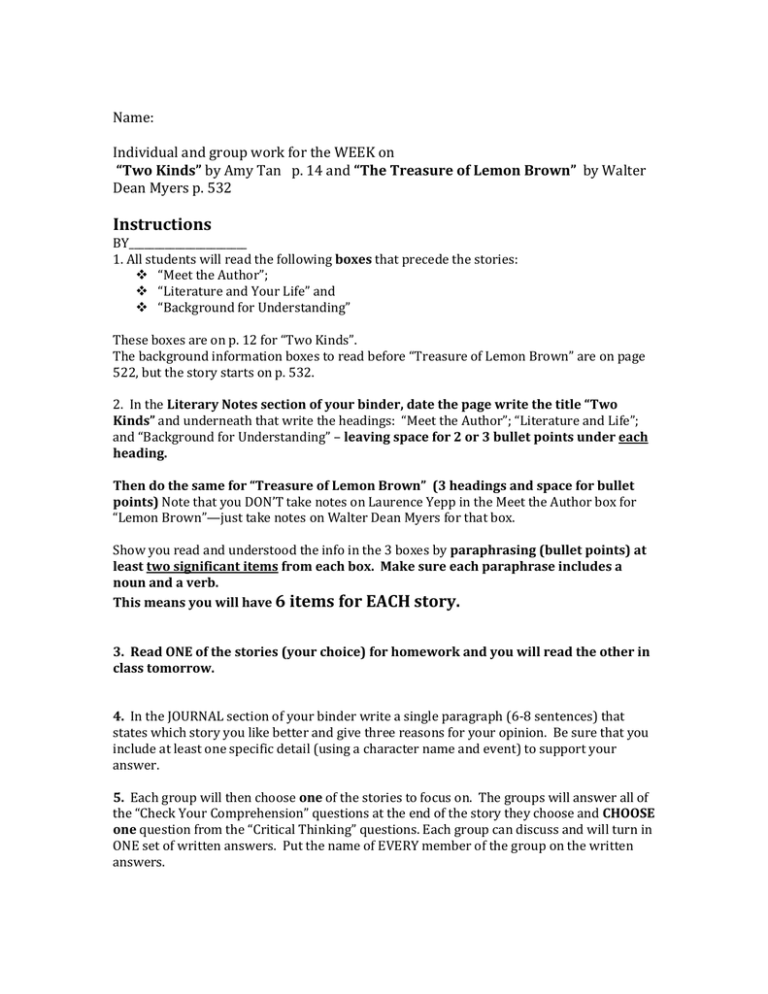two kinds and lemon brown comparison
advertisement

Name: Individual and group work for the WEEK on “Two Kinds” by Amy Tan p. 14 and “The Treasure of Lemon Brown” by Walter Dean Myers p. 532 Instructions BY_______________________ 1. All students will read the following boxes that precede the stories: “Meet the Author”; “Literature and Your Life” and “Background for Understanding” These boxes are on p. 12 for “Two Kinds”. The background information boxes to read before “Treasure of Lemon Brown” are on page 522, but the story starts on p. 532. 2. In the Literary Notes section of your binder, date the page write the title “Two Kinds” and underneath that write the headings: “Meet the Author”; “Literature and Life”; and “Background for Understanding” – leaving space for 2 or 3 bullet points under each heading. Then do the same for “Treasure of Lemon Brown” (3 headings and space for bullet points) Note that you DON’T take notes on Laurence Yepp in the Meet the Author box for “Lemon Brown”—just take notes on Walter Dean Myers for that box. Show you read and understood the info in the 3 boxes by paraphrasing (bullet points) at least two significant items from each box. Make sure each paraphrase includes a noun and a verb. This means you will have 6 items for EACH story. 3. Read ONE of the stories (your choice) for homework and you will read the other in class tomorrow. 4. In the JOURNAL section of your binder write a single paragraph (6-8 sentences) that states which story you like better and give three reasons for your opinion. Be sure that you include at least one specific detail (using a character name and event) to support your answer. 5. Each group will then choose one of the stories to focus on. The groups will answer all of the “Check Your Comprehension” questions at the end of the story they choose and CHOOSE one question from the “Critical Thinking” questions. Each group can discuss and will turn in ONE set of written answers. Put the name of EVERY member of the group on the written answers. BY______________________________________ 6. Each group will create a HUMAN paraphrase to retell the story. Remember that when you paraphrase be sure to include character names and strong verbs to tell WHO DOES WHAT. Include every event that is a “domino” that CAUSES the next important plot conflict to begin or resolve. You should aim to have at least 2 paraphrases per column of text—this would mean an average of 4 simple sentences to explain key events on a single page. (You will have a little less on the pages that have less text and more pictures.) 7. Each group will present at least 2 pages of text for a group grade. You will not know which pages you have to present ahead of time so do a great job on EVERY page. BY __________________________ PART II: THEME Groups will then consider whether the author of the story they focused on might agree or disagree with at least 3 of the following thematic statements. Be prepared to cite specific plot events and characters’ traits to support your group’s opinions. Also think about how the main characters change from the beginning to the end of the story. Reread (or at least skim) the text for passages that can support your opinions, and take notes of passages (page and column numbers) to refer to during a full class GRADED Socratic Circle discussion. 1. Adults (especially parents) forget what it was like to be a kid. 2. Adults set unrealistically high expectations for kids entering their teens. 3. Freedom to choose your own way is the most important element for success. 4. Taking risks and failing prevents future success. 5. There are clear differences between good people and bad people. 6. It helps you know yourself better when you consider things from someone else’s point of view. 7. We cannot learn from the words and stories of others. We have to make our own mistakes to learn lasting lessons.





